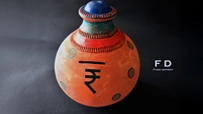Understanding Term Deposit Rates: A Comprehensive Guide to Smart Investing
August 04, 2025

Whether you're just starting your financial journey or looking to refine your investment strategy, understanding different investment options is crucial. One such option is term deposit – a bank deposit that offers a secure way to grow your savings.
The two most popular term deposit instruments are Fixed Deposits and Recurring Deposits. However, as an investor, you should have a basic understanding on term deposit rates so that you can invest smartly to maximise returns.
Term Deposit Rates Explained
Term deposit rates refer to the interest rates offered by banks on their term deposit accounts, generally FD and RD. These rates may vary depending on factors such as the deposit amount and tenure.
For instance, some banks offer higher interest rates for a shorter deposit tenure of 12 months. However, to make an informed decision, it's important to consider your financial goals and aspirations before choosing a tenure. The point is don't just go by higher interest rates. Take factors such as your investment objective and the compounding effect of FDs (more on this later) for long-term growth into consideration.
The interest rate offered varies across issuers. However, for ease of understanding, we have compared Ujjivan SFB's Digital Fixed Deposit interest rate and Senior Citizen FD interest rate (as on 05 Aug 2025).
| Tenure | Interest Rate Interest Rate (p.a.)* (Under ₹ 3 Crores) | Interest Rate (p.a.)* (Under ₹ 3 Crores) (For Senior Citizens) |
|---|---|---|
| 7 days to 29 days | 3.50% | 4.00% |
| 30 days to 89 days | 4.15% | 4.65% |
| 90 days to 179 days | 4.65% | 5.15% |
| 180 days | 6.00% | 6.50% |
| 6 months to < 12 months | 5.50% | 6.00% |
| 12 months to < 24 months | 7.25% | 7.75% |
| 24 months | 7.45% | 7.95% |
| 24 months 1 day to 990 days | 7.25% | 7.75% |
| 991 days to 60 months | 7.20% | 7.70% |
| 60 months 1 day to 120 months | 6.50% | 7.00% |
*Disclaimer: Interest rates are subject to periodic changes and the applicable interest rates will be given based on the date and time of receipt of the funds by the Bank.
So, why these interest rates vary for different tenures?
One of the primary reasons is that banks strive to maintain a balance between their assets and liabilities. Assets include loans and investments owned by the bank, while liabilities comprise obligations to depositors and creditors. are what the bank owns, such as loans and investments. To strike a balance between ALM (Asset Liability Management) ratio, banks offer different rates for different tenures. However, this is only one of the reasons. Other reasons may include liquidity concerns, competition with other banks, etc.
Factors Influencing Term Deposit Rates
Several factors influence term deposit rates. Some of them are listed below.
1. Repo Rate
The repo rate is the interest rate at which the RBI lends money to commercial banks. When the RBI changes the repo rate, it usually has a ripple effect on bank interest rates. Banks adjust their deposit rates in response to changes in the repo rate. Generally, banks increase deposit rates when repo rate increases and vice versa.
2. Economic Condition
Overall economic condition, including GDP growth and inflation rates may impact term deposit rates. Higher inflation might prompt banks to raise deposit rates to attract funds and preserve purchasing power.
3. Demand and Supply
Banks may adjust their deposit rates based on the demand for loans and their need for deposits to fund these loans.
4. Investor Age
Banks generally offer preferential rates to senior citizens, usually 0.50%* p.a. higher than the regular deposit rates.
5. Market Competition
Banks compete for deposits from customers. Fierce competition can lead banks to adjust their deposit rates to attract or retain customers, especially during periods where loan demand is low.
6. Type of Product
Premium FD schemes can come with higher interest rates compared to regular schemes. These schemes usually offer additional benefits and are designed for a certain segment of customers.
Term Deposit Rates: How is the Interest Paid?
The interest on RDs is calculated and compounded quarterly, meaning it's calculated on the principal amount plus any interest earned during previous quarters. At the end of each quarter, the interest earned for that particular quarter is credited in the RD account. At the time of maturity, the total amount accumulated includes both the principal amount deposited and the interest earned over the period.
Before we talk about Fixed Deposits, let's first understand cumulative and non-cumulative FDs.
A cumulative FD is a type of deposit where the interest amount earned on the deposit is reinvested into the principal amount instead of being paid out periodically. The interest is compounded quarterly or annually throughout the deposit tenure leading to higher overall returns.
Unlike cumulative FDs, non-cumulative FDs offer periodic interest pay outs (monthly, quarterly, or annually). These FDs are suitable for depositors seeking a regular income stream.
Banks generally offer flexibility in choosing interest pay-out frequency based on the depositor's preference and needs.
Finding the Best Term Deposit Rates
To ensure you get the best possible returns from your term deposit, it's essential to compare rates offered by different banks. Generally, Small Finance Banks offer better deposit rates compared to traditional banks,
Consider the following factors when comparing term deposit interest rates:
1. Investment Tenure
Compare different tenures with your financial goals. You may earn better returns if you stay invested for a longer period. However, if you have short-term goals, you may opt for a shorter tenure. Consider these factors before investing in term deposits.
2. Interest Payment Frequency
Do you need a regular income stream or do you want to reinvest your FD till the time of maturity? If you seek frequent interest pay outs, you may opt for non-cumulative FDs. The interest is paid to the investor on a monthly, quarterly, half-yearly or annual basis depending on the chosen frequency.
However, if you have a long-term investment horizon, cumulative FDs could be a better option. In cumulative FDs, the interest is compounded annually and reinvested along with the principal amount every year. This compounding effect results in overall higher returns at the time of maturity.
Evaluate your financial goals and liquidity needs, and open an FD accordingly.
3. Keep a tab on Monetary Policy
You may consider keeping a close eye on RBI's monetary policy. Whenever repo rate increases, banks usually hike their term deposit rates - you can invest accordingly.
4. FD Laddering
FD laddering involves spreading your investments across FDs with staggered maturity dates to balance liquidity and maximise interest rates.
5. Use FD ROI Calculator
An FD ROI Calculator can help you calculate your returns based on tenure, deposit amount and interest rate. You can use the calculator to compare returns and invest accordingly
FDs and the Power of Compounding
Unlike simple interest, which is calculated only on the principal amount, compound interest considers the accrued interest from previous periods. It's like a snowball effect where your money multiplies as it earns interest not only on the principal amount but also on the interest you have already earned. Compound interest coupled with high-yield FDs, has the potential to offer maximum returns. However, this facility is available only for cumulative FDs.
Term Deposit Rates: Risks Involved
While term deposits are generally considered safe investments, there are inflation risks associated with them.
Inflation risk arises from the fact that term deposit interest rates may not keep pace with inflation. This means that even though your money is earning interest, its purchasing power could decrease over time.
Final Thoughts
Understanding term deposit rates is crucial for making informed investment decisions. By comparing rates, calculating potential earnings, and considering other factors such as investment period and interest payment frequency, you can find the best term deposit account that suits your financial goals.
Looking to grow your savings? Ujjivan SFB offers a wide range of fixed deposit products, including Digital Fixed Deposit. Select the FD of your choice and take a step forward to your financial goals. Alternatively, you can browse through Ujjivan SFB product suite - our wide range of financial products are designed to make your financial life better.
Disclaimer:
The contents herein are only for informational purposes and generic in nature. The content does not amount to an offer, invitation or solicitation of any kind to buy or sell, and are not intended to create any legal rights or obligations. This information is subject to updation, completion, amendment and verification without notice. The contents herein are also subject to other product-specific terms and conditions, as well as any applicable third-party terms and conditions, for which Ujjivan Small Finance Bank assumes no responsibility or liability.
Nothing contained herein is intended to constitute financial, investment, legal, tax, or any other professional advice or opinion. Please obtain professional advice before making investment or any other decisions. Any investment decisions that may be made by the you shall be at your own sole discretion, independent analysis and evaluation of the risks involved. The use of any information set out in this document is entirely at the user’s own risk. Ujjivan Small Finance Bank Limited makes no representation or warranty, express or implied, as to the accuracy and completeness for any information herein. The Bank disclaims any and all liability for any loss or damage (direct, indirect, consequential, or otherwise) incurred by you due to use of or due to investment, product application decisions made by you on the basis of the contents herein. While the information is prepared in good faith from sources deemed reliable (including public sources), the Bank disclaims any liability with respect to accuracy of information or any error or omission or any loss or damage incurred by anyone in reliance on the contents herein, in any manner whatsoever.
To know more about Ujjivan Small Finance Bank Products Visit:"https://www.ujjivansfb.in"
All intellectual property rights, including copyrights, trademarks, and other proprietary rights, pertaining to the content and materials displayed herein, belong
to Ujjivan Small Finance Bank Limited or its licensors. Unauthorised use or misuse of any intellectual property, or other content displayed herein is strictly prohibited and the same is not intended for distribution to, or use by, any person in any jurisdiction where such distribution or use would (by reason of that person’s nationality, residence or otherwise) be contrary to law or registration or would subject Ujjivan Small Finance Bank Limited or its affiliates to any licensing or registration requirements.
FAQs
1. How are term deposits different from savings accounts?
For term deposits, funds are locked in for a fixed period, which could vary from 7 days to 10 years. However, such is not the case with savings accounts – you can deposit and withdraw funds freely from savings accounts without incurring any penalties. Please note that for callable FDs, Ujjivan Small Finance Bank doesn’t impose any penalty fee for withdrawals made after 6 months from the time of deposit.
Generally, term deposits offer higher interest rates (for certain tenures) compared to savings accounts.
2. Are term deposits taxable?
Yes, the interest earned from term deposits is taxable as per your income tax slab rate. Banks deduct tax at source (TDS) if the interest amount exceeds ₹40,000. For senior citizens, the exemption limit is capped at ₹50,000. Please note that this TDS exemption on FD interest is applicable for FY 2024-25 (till March 2025). For FY 2025-26, the current TDS exemption limit has been hiked to ₹50,000 for regular citizens and ₹1 lakh for senior citizens.
3. Can I add more money to my term deposit after opening it?
No, term deposits do not allow additional deposits once the account is opened. The initial deposit amount remains fixed throughout the investment period.
4. Are term deposits insured?
The Deposit Insurance and Credit Guarantee Corporation (DICGC) provides deposit insurance of ₹5 lakh per account holder per bank, including principal and interest. Let’s say, you have an FD in a single bank amounting to ₹20 lakh. The amount insured will be ₹5 lakh only. However, if you split your FDs in 4 different banks (₹5 lakh in each bank), each of your FDs will be eligible for ₹5 lakh insurance under DICGC policy.
Latest Blogs

Dussehra 2025: How to Win Your Financial Battles with Smart Saving
Dussehra 2025 (also known as Vijayadashami) falls on Thursday, October 2, 2025.

eSIM Scam in India: I4C Warns Mobile Users About Rising Fraud – How to Stay Safe
The Indian Cybercrime Coordination Centre (I4C), a wing of the Ministry of Home Affairs, issued a strong warning to mobile users about the rapid increase in eSIM fraud in India.

How to Link PAN with Aadhaar: Step-by-Step Guide & Consequences of Not Linking
Linking your Permanent Account Number (PAN) with your Aadhaar is no longer just a best practice.

Annual Information Statement (AIS): A Complete Guide for Stress-Free ITR Filing
India’s tax season is in its final stretch.

ITR-1 (Sahaj) Restrictions: Income Sources Not Allowed & Filing Rules
With just a few days left before the 15 September 2025 deadline for filing Income Tax Returns (ITRs) for Assessment Year (AY) 2025-26, many taxpayers are rushing to submit their forms online.





